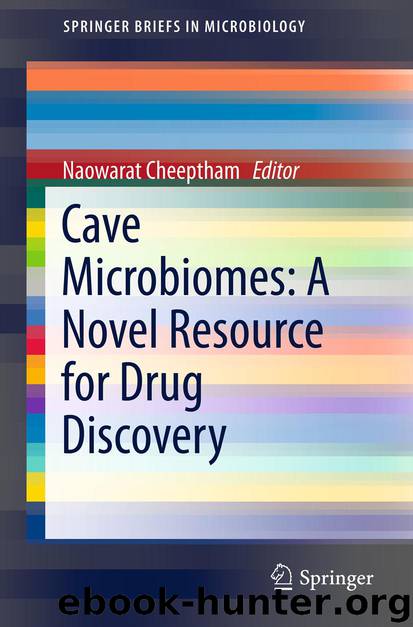Cave Microbiomes: A Novel Resource for Drug Discovery by Naowarat Cheeptham

Author:Naowarat Cheeptham
Language: eng
Format: epub
Publisher: Springer New York, New York, NY
Logging debris nearly choking a cave entrance in a sinkhole, Vancouver Island (Photo courtesy of Ken Sinkiewicz)
Fortunately, broad societal awareness of environmental issues in the Western world has increased dramatically over the last half century, creating a more positive climate for cave conservation than existed in the days of commercial guano and speleothem mining, when sewage was diverted into caves and sinkholes were used as convenient garbage dumps.
By the 1980s, responding to the obviously legitimate concerns of the small, organized caving community, a few sympathetic staff members within the British Columbia Forest Service began to develop guidelines for timber harvesting in karst areas. Still, it was another 20 years before legislation and regulation provided any legal compulsion in support of the evolving “best management practices”. Meanwhile, in the USA and other countries, cavers and environmentalists had succeeded in lobbying for legislation that would protect cave and karst resources both from damaging activities underground and from surface activities. Possibly because Canada lacks America’s innumerable private commercial caves and high-profile tourist caves such as Carlsbad, Mammoth, Wind and Jewel, Canadian caves remain well below the radar in terms of public understanding and governments have been slow to develop legislation that publicly affirms cave resource values and effectively protects them. Even if no caver ever set foot in a cave, conservation of cave resources would be far from assured.
In British Columbia, for example, the current legal framework has given cave/karst conservation issues greater profile with the forest industry. However, it applies only to forestry-related industrial activities and has no application to mining, quarrying, hydropower generation, highway construction, real estate development or any of the many other surface activities that potentially can impact cave and karst resources. Additionally, the current “results based” regulations may well be virtually impossible to enforce, as they rely on evidence of damage to cave systems that can be demonstrated conclusively only if detailed baseline conditions had been recorded before the industrial disturbance took place. While in the USA, 26 internal jurisdictions and the federal government have specific cave conservation legislation in place, Canada has none. In British Columbia, cave resources are protected by law only if they lie within Provincial Parks or formally designated Provincial Recreation Sites, are subject to damage by industrial forestry activities, or are explicitly protected under Heritage Conservation legislation, blanket provisions of which cover only archaeological resources. If legislation is seen as a means of “setting the bar” for particular societal values, British Columbia clearly has yet to recognize adequately the value of its cave resources. Protection of cave/karst resources from both industrial scale impacts and deliberate damage by underground visitors remains patchy and inadequate.
As noted previously, communication and education are key to promoting cave conservation, both inside the organized caving community and across the broader society. As cavers, we realize that, whatever we may have achieved in terms of cave resource protection, we still have much to learn and to do. This sense of responsibility can sometimes detract from the enjoyment of simply “going
Download
This site does not store any files on its server. We only index and link to content provided by other sites. Please contact the content providers to delete copyright contents if any and email us, we'll remove relevant links or contents immediately.
| Administration & Medicine Economics | Allied Health Professions |
| Basic Sciences | Dentistry |
| History | Medical Informatics |
| Medicine | Nursing |
| Pharmacology | Psychology |
| Research | Veterinary Medicine |
Tuesdays with Morrie by Mitch Albom(4690)
Yoga Anatomy by Kaminoff Leslie(4306)
Science and Development of Muscle Hypertrophy by Brad Schoenfeld(4089)
Bodyweight Strength Training: 12 Weeks to Build Muscle and Burn Fat by Jay Cardiello(3914)
Introduction to Kinesiology by Shirl J. Hoffman(3725)
How Music Works by David Byrne(3187)
Sapiens and Homo Deus by Yuval Noah Harari(2987)
The Plant Paradox by Dr. Steven R. Gundry M.D(2547)
Churchill by Paul Johnson(2506)
Insomniac City by Bill Hayes(2498)
Coroner's Journal by Louis Cataldie(2432)
Hashimoto's Protocol by Izabella Wentz PharmD(2331)
The Chimp Paradox by Peters Dr Steve(2297)
The Universe Inside You by Brian Clegg(2097)
Don't Look Behind You by Lois Duncan(2080)
The Immune System Recovery Plan by Susan Blum(2027)
The Hot Zone by Richard Preston(1983)
Endure by Alex Hutchinson(1964)
Woman: An Intimate Geography by Natalie Angier(1882)
